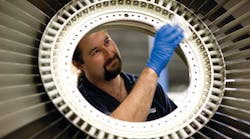Maintenance, Repair and Overhaul: Secret Weapon for Success
Recession-resilient companies in the aerospace and defense (A&D) industry have mastered a tactic that can provide a valuable model for the new breed of companies—or any manufacturer—worried about budgets cuts.
During the lean defense spending era of the late ‘70s, the A&D industry learned that revenue needs to come from more than government spending. The emergence of the aftermarket service industry saved many A&D contractors from post Vietnam-era budget cut peril.
The “secret weapon” not only paid off, but also produced an unexpected result—the development of a new level of customer intimacy, which helps those service-invested companies coast through challenging economic times both in the ‘70s and through the newest era of recession woes.
The role of service in developing customer loyalty is a valuable lesson that should be studied by any company in any industry that is subject to volatile market conditions. This is now clear: The service operation can be a saving grace.
Looming budget cuts and reductions in defense spending undeniably pose threats to growth for some A&D manufacturers, suppliers and contractors. Any fluctuation in U.S. government spending has a far-reaching ripple effect. Vendors, supply chains and related engineers and contractors worldwide feel the impact when changes in programs, priorities and expectations emanate from Capitol Hill.
This should hardly be a surprise.
Volatility in the A&D industry is inevitable as the influence of politics, world unrest, instability of emerging nations and isolationists’ sentiments and domestic focus swing like a pendulum.
Despite this reality, the powerhouses of the A&D industry survive. Many, in fact, flourish, often thanks to their divisions that provide preventive maintenance, inspections, break-fix repairs or complete system overhauls. After all, when spending for new equipment decreases, service on the old equipment tends to increase.
The companies who have efficient systems in place for managing the service operation will win those MRO (maintenance, repair and overhaul for commercial and defense aircraft) contracts.
Service must be efficient in order to be cost effective and profitable. Because of its complexity and labor intensive operations, the service division must be managed with extreme attention to cost control, technician productivity and streamlined processes.
There is no room for gaps in communication caused by disparate systems, delays due to lack of parts availability or questions around configurations, schematics, components, warranties or program mandates.
The High Tech Advantage
Advanced technology gives service-centric companies many advantages. Not only does service provide an additional source of revenue, it provides a way to build relationships with customers and create long-term loyalties that supersede price and budget issues. Relationships can be built around value-added sharing of historical data, collaboration on design and predictive analysis of future needs and trends.
Technology available today also allows companies to be more strategic, responsive and in tune to customer needs. This level of customer intimacy generates insights about future needs and allows companies to plan and schedule workforce, inventory and capacity with confidence. All of these insights lead to greater forecasting abilities and efficiency—necessary for riding out periods of volatile pricing and market pressures.
For example, creating customer-specific maintenance programs – proactive systems for identifying when repair vs. replace strategies, monitoring regulation compliance service alerts and warranty status on components – helps to cement relationships.
Integrated CRM functionality helps support this account management tactic and identify related sales opportunities that arise.
When the service technician becomes a trusted advisor, recommendations for purchases, equipment upgrades and parts replacements are more readily adopted—often bypassing lengthy quoting and approval processes.
Companies can also increase the level of their value-added service by increasing the speed of delivery, surpassing what any competitor can deliver. This all but ensures ongoing MRO contracts.
Speed is the critical element that can’t be underestimated. Keeping aircrafts operational and air-worthy, after all, is what it is all about.
The ability to respond quickly to service bulletins and aircraft directives is essential for allowing contractors to view the entire product lifecycle as a closed loop—from design and engineering through delivery and preventive maintenance and ongoing repairs. Tracking the details, from source documents to modifications and as-serviced configurations are critical to the level of confidence that must be present.
Trust is the key to the relationship between suppliers, sub-contractors, manufacturers and MRO contractors in A&D—and many other vertical industries dealing with mission critical equipment. In each, data is the foundation of trust and detailed analytics prove when investments in new units are needed and cost effective.
Meeting the End Goals
Increased sales are certainly one of the goals of establishing or enhancing a value-added service and MRO operations.
In addition to the revenue, though, it is important to keep in mind that the relationship it generates with the customer is an important by-product. This relationship leads to loyalty and a codependent state of collaboration and innovation. The relationship will outlast periodic swings in budgets and spending.
As the A&D industry continues to evolve its business models, processes and IT infrastructure to meet changing market demands, this lesson about the intrinsic value of MRO operations is an important one to remember.
Enhancing MRO capabilities to be more customer-attuned, responsive and cost effective, will offer any A&D company a powerful weapon against inevitable fluctuations in U.S. government spending. Investing in functionality to reinforce the customer relationship is a defensive tactic—that also makes a smart offensive move.
Edward Talerico is the aerospace and defense industry strategy director for Infor.




